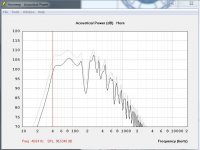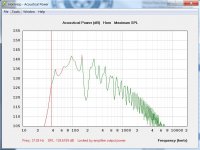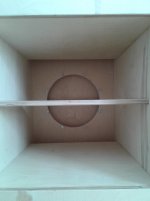
Martinsson's Blog - ROAR15
They seem to fit nicely into a pair of ROAR15.
Grey response curve is indoor and black response curve is free field outdoors (2,0 Pi).

A single ROAR15 with your RCF driver in 2.0 Pi and 1800 watts of power...
Considering that most of the energy content in modern music is centered around 80 Hz - tells me that it should be plenty loud and with a very nice tactile and physical mid bass punch (which is the exact feedback we have got from builders of this design).
ROAR15 is quite a bit larger and heavier then the THAM15, but will give much more output in the mid bass region and a much more pronounced tactile "kick" (which is easy to adjust to taste with a single point of EQ).
The ROAR15 is more powerful and has a higher resolution in my experience. It can be a bit physical and overwhelming indoors at high spl, but will reproduce music with all the energizing punch and dynamics needed.
The ROAR15 is more powerful and has a higher resolution in my experience. It can be a bit physical and overwhelming indoors at high spl, but will reproduce music with all the energizing punch and dynamics needed.
Tham and Roar designs are only good for up to 100Hz. If you want clean 150-200Hz, go for front loaded horn (most efficient) or standard reflex designs.
It works in fairly small reflex enclosures too.
It works in fairly small reflex enclosures too.
Last edited:
Thanks, for your input. I read somewhere that this driver with a Qts of 0.22 would not perform that well in a reflex cabinet and is better suited in a bandpass application. But i every design is a compromise i guess.
Is there a front loaded horn design that you can recommend?
Is there a front loaded horn design that you can recommend?
Well ofcourse you can try to design horn or 6th order band bass for that driver if you cant find any designs.
To get low with front loaded horns, it needs to be quite a big. Bandpass is a lot smaller and works well indoors (horns are best in outdoors or large spaces).
To get low with front loaded horns, it needs to be quite a big. Bandpass is a lot smaller and works well indoors (horns are best in outdoors or large spaces).
As example, n401 models pretty nice in 6th bp where:
back chamber = 150 litres, tuned to 38 Hz
front chamber = 40 litres, tuned to 75 Hz
Its a good idea to use large square tunnels/ports instead of circular tubes for maximum air coupling efficiency.
cyn: bp6, green: reflex

However, 6th bandpass is only good at narrow band width.
back chamber = 150 litres, tuned to 38 Hz
front chamber = 40 litres, tuned to 75 Hz
Its a good idea to use large square tunnels/ports instead of circular tubes for maximum air coupling efficiency.
cyn: bp6, green: reflex

However, 6th bandpass is only good at narrow band width.
Last edited:
Its a good idea to use large square tunnels/ports instead of circular tubes for maximum air coupling efficiency.

(From Anders Martinsson blog)
And if you make it 8th order instead of 6th order then we are back to the ROAR-design again... 😀
Why should he build an even more bandwidth limited design if the ROAR is too band width limited in your opinion?
How low do you like it to play, 40 Hz, 30 Hz, 50 Hz?Is there a front loaded horn design that you can recommend?
What are your thoughts comparing the ROAR15 with the Tham15?
Soundwise I would subjectivly describe the difference as that the ROAR15 is sharper, harder, more precise in its character, it is a bigger more capable design and that also comes through, but these are just my own impressions, as for the soudquality I actually prefer it over the THAM15, but that is a personal preference only.
Concerning the statement made previously in this thread that Tham and Roar designs are only good for up to 100Hz, I disagree since this does not corespond to either messurements, personal expirience or reported sucsesful usercases, it might have been a personal opinion in which case that is just fine, but that was not how it was stated so I felt I had to write this, no offence intended and hopefully none taken.
Personally I find the ROAR15 fully usable up to ~150Hz, currently I cross them over at 158Hz 48dB/Oct LR, and iy works a treat, in my opinion, but this is their absolute upper limit for sure.
40 Hz would be sufficient.How low do you like it to play, 40 Hz, 30 Hz, 50 Hz?
- Home
- Loudspeakers
- Subwoofers
- Cabinet for RCF LF15N401